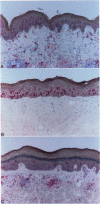Abstract
The aim of this study was to determine cytokines in human leprosy lesions by means of immunohistologic examination. Cryostat sections of skin biopsies from 57 patients with various forms of leprosy were immunostained according to the APAAP method, using monoclonal antibodies against interleukin-1 beta (IL-1 beta), tumor necrosis factor-alpha (TNF-alpha), interferon-gamma (IFN-gamma), and, in addition, against CD 1 antigen. Granulomas in biopsies of untreated patients with tuberculoid leprosy showed large amounts of cells positive for IL-1 beta, TNF-alpha, IFN-gamma, and CD 1, whereas no positive signals could be detected in untreated patients with lepromatous leprosy. However, in those biopsies obtained from lepromatous leprosy patients undergoing chemotherapy, positive staining for cytokines as well as subepidermal Langerhans cells increased to a detectable amount. Remarkably, in tuberculoid leprosy patients, the number of IL-1 beta--positive cells did not vary under therapy, while the number of TNF-alpha and IFN-gamma reactive cells decreased. These results suggest that immunohistologic determination of cytokines in combination with the assessment of subepidermal Langerhans cells in human leprosy lesions may be used as a parameter for the patient's status of cell-mediated immunity under chemotherapeutic treatment.
Full text
PDF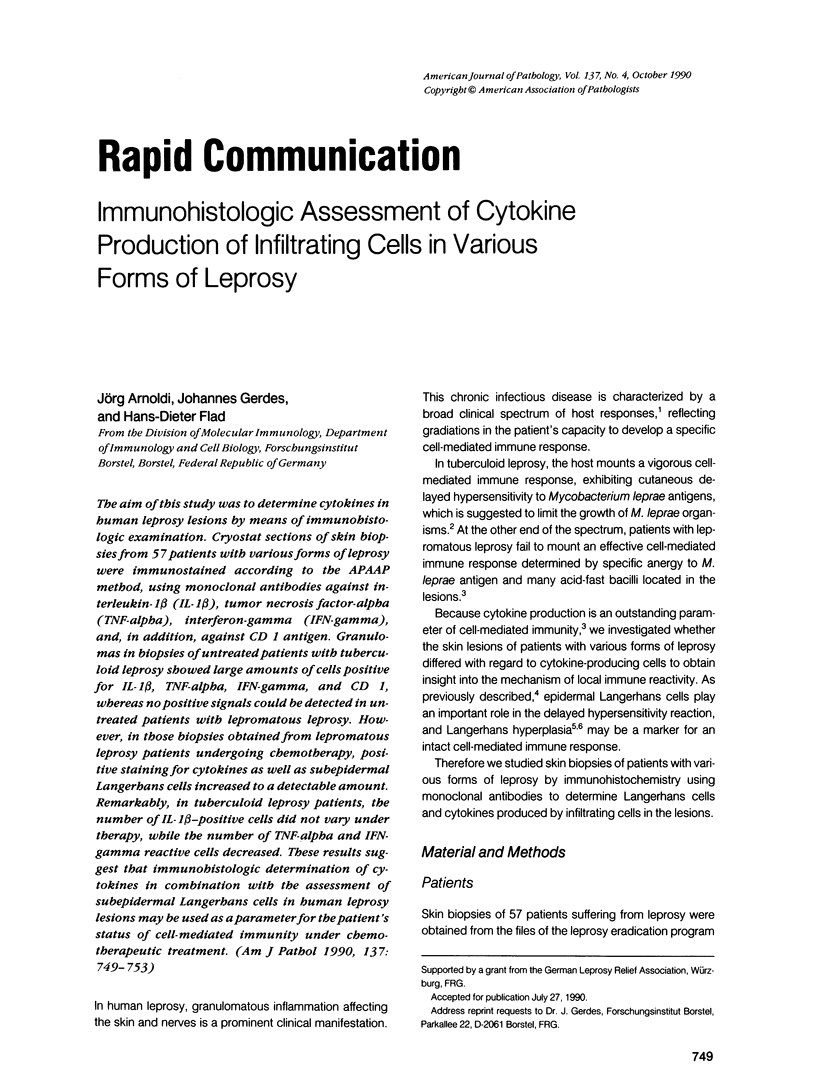
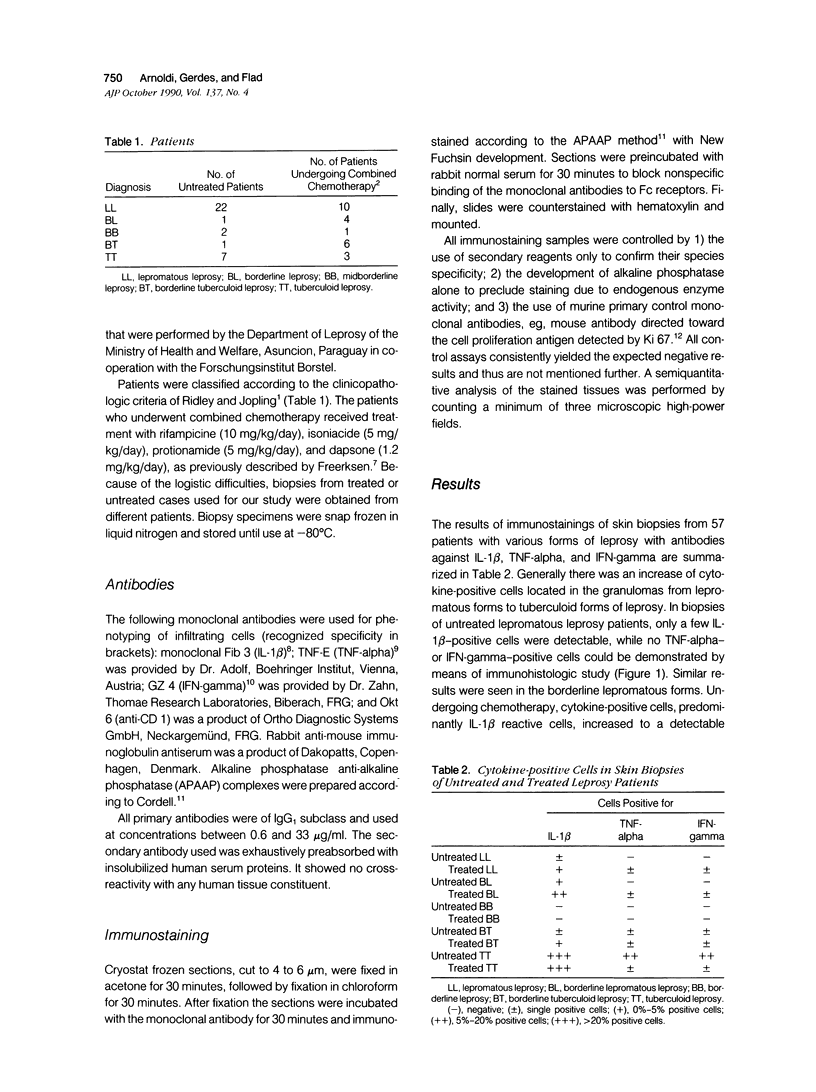
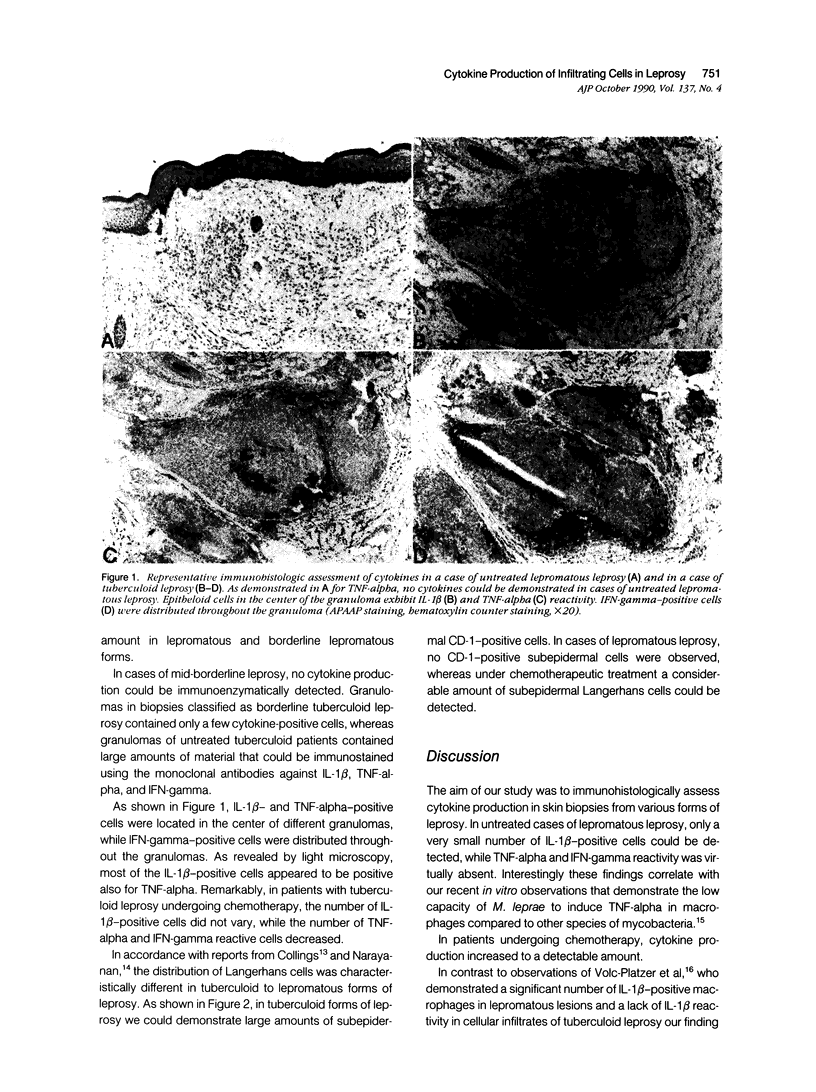
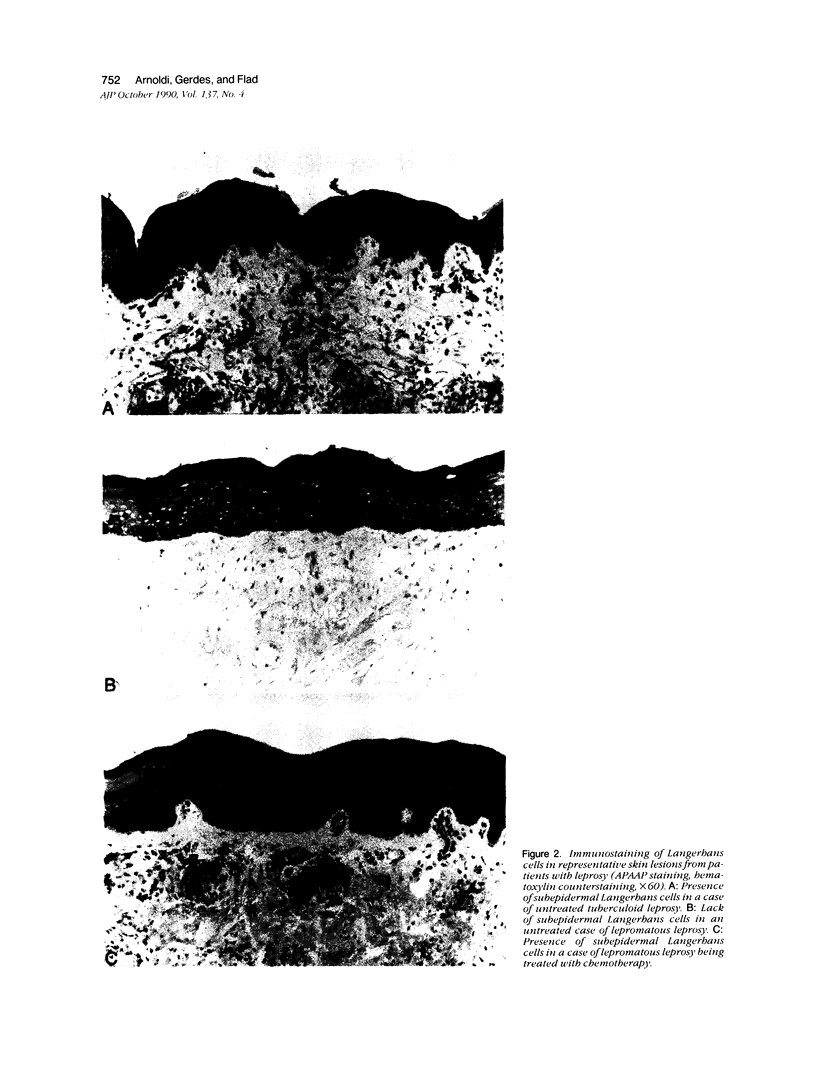
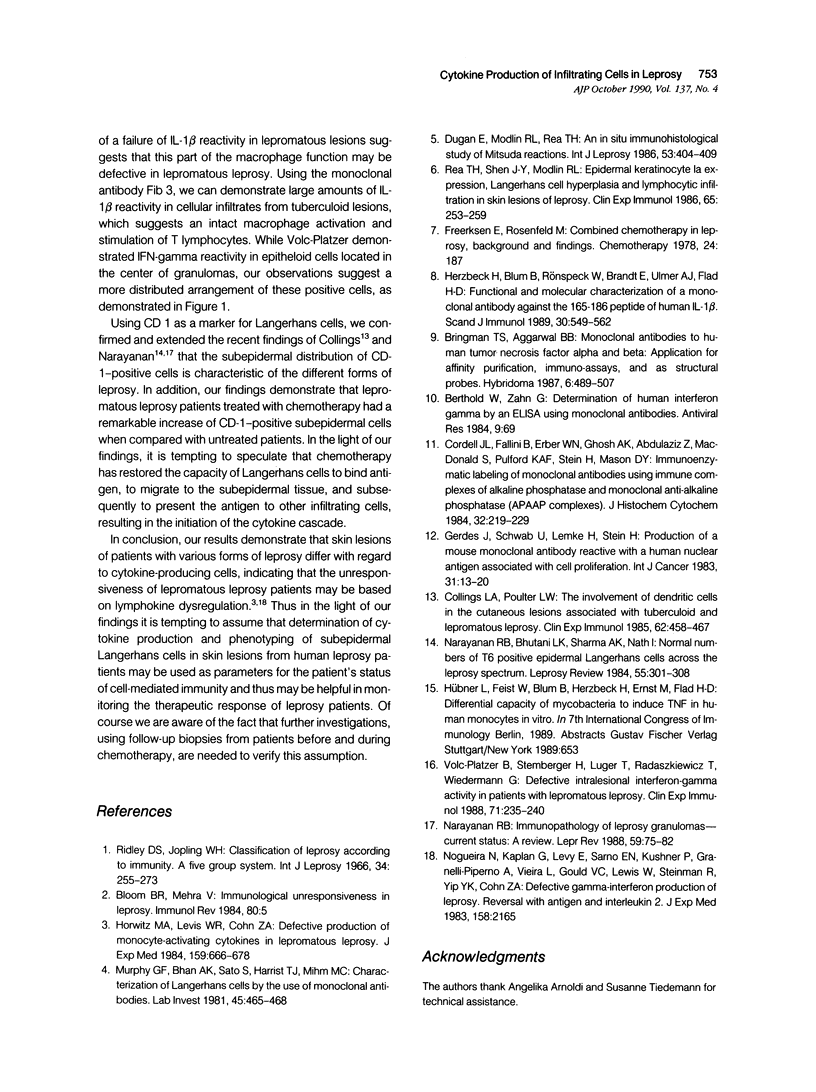
Images in this article
Selected References
These references are in PubMed. This may not be the complete list of references from this article.
- Bloom B. R., Mehra V. Immunological unresponsiveness in leprosy. Immunol Rev. 1984 Aug;80:5–28. doi: 10.1111/j.1600-065x.1984.tb00493.x. [DOI] [PubMed] [Google Scholar]
- Bringman T. S., Aggarwal B. B. Monoclonal antibodies to human tumor necrosis factors alpha and beta: application for affinity purification, immunoassays, and as structural probes. Hybridoma. 1987 Oct;6(5):489–507. doi: 10.1089/hyb.1987.6.489. [DOI] [PubMed] [Google Scholar]
- Collings L. A., Waters M. F., Poulter L. W. The involvement of dendritic cells in the cutaneous lesions associated with tuberculoid and lepromatous leprosy. Clin Exp Immunol. 1985 Dec;62(3):458–467. [PMC free article] [PubMed] [Google Scholar]
- Cordell J. L., Falini B., Erber W. N., Ghosh A. K., Abdulaziz Z., MacDonald S., Pulford K. A., Stein H., Mason D. Y. Immunoenzymatic labeling of monoclonal antibodies using immune complexes of alkaline phosphatase and monoclonal anti-alkaline phosphatase (APAAP complexes). J Histochem Cytochem. 1984 Feb;32(2):219–229. doi: 10.1177/32.2.6198355. [DOI] [PubMed] [Google Scholar]
- Dugan E., Modlin R. L., Rea T. H. An in situ immunohistological study of Mitsuda reactions. Int J Lepr Other Mycobact Dis. 1985 Sep;53(3):404–409. [PubMed] [Google Scholar]
- Freerksen E., Rosenfeld M., Bonnici E., Depasquale G., Kriiger-Thiemer M. Combined therapy in leprosy. Background and findings. Chemotherapy. 1978;24(3):187–201. doi: 10.1159/000237780. [DOI] [PubMed] [Google Scholar]
- Gerdes J., Schwab U., Lemke H., Stein H. Production of a mouse monoclonal antibody reactive with a human nuclear antigen associated with cell proliferation. Int J Cancer. 1983 Jan 15;31(1):13–20. doi: 10.1002/ijc.2910310104. [DOI] [PubMed] [Google Scholar]
- Herzbeck H., Blum B., Rönspeck W., Frenzel B., Brandt E., Ulmer A. J., Flad H. D. Functional and molecular characterization of a monoclonal antibody against the 165-186 peptide of human IL-1 beta. Scand J Immunol. 1989 Nov;30(5):549–562. doi: 10.1111/j.1365-3083.1989.tb02462.x. [DOI] [PubMed] [Google Scholar]
- Horwitz M. A., Levis W. R., Cohn Z. A. Defective production of monocyte-activating cytokines in lepromatous leprosy. J Exp Med. 1984 Mar 1;159(3):666–678. doi: 10.1084/jem.159.3.666. [DOI] [PMC free article] [PubMed] [Google Scholar]
- Murphy G. F., Bhan A. K., Sato S., Harrist T. J., Mihm M. C., Jr Characterization of Langerhans cells by the use of monoclonal antibodies. Lab Invest. 1981 Nov;45(5):465–468. [PubMed] [Google Scholar]
- Narayanan R. B., Bhutani L. K., Sharma A. K., Nath I. Normal numbers of T6 positive epidermal langerhans cells across the leprosy spectrum. Lepr Rev. 1984 Sep;55(3):301–308. doi: 10.5935/0305-7518.19840034. [DOI] [PubMed] [Google Scholar]
- Narayanan R. B. Immunopathology of leprosy granulomas--current status: a review. Lepr Rev. 1988 Mar;59(1):75–82. [PubMed] [Google Scholar]
- Nogueira N., Kaplan G., Levy E., Sarno E. N., Kushner P., Granelli-Piperno A., Vieira L., Colomer Gould V., Levis W., Steinman R. Defective gamma interferon production in leprosy. Reversal with antigen and interleukin 2. J Exp Med. 1983 Dec 1;158(6):2165–2170. doi: 10.1084/jem.158.6.2165. [DOI] [PMC free article] [PubMed] [Google Scholar]
- Rea T. H., Shen J. Y., Modlin R. L. Epidermal keratinocyte Ia expression, Langerhans cell hyperplasia and lymphocytic infiltration in skin lesions of leprosy. Clin Exp Immunol. 1986 Aug;65(2):253–259. [PMC free article] [PubMed] [Google Scholar]
- Ridley D. S., Jopling W. H. Classification of leprosy according to immunity. A five-group system. Int J Lepr Other Mycobact Dis. 1966 Jul-Sep;34(3):255–273. [PubMed] [Google Scholar]
- Volc-Platzer B., Stemberger H., Luger T., Radaszkiewicz T., Wiedermann G. Defective intralesional interferon-gamma activity in patients with lepromatous leprosy. Clin Exp Immunol. 1988 Feb;71(2):235–240. [PMC free article] [PubMed] [Google Scholar]




